Vegan Vanillekipferl – vanilla crescent cookies – with a crumbly, melt-in-the-mouth texture and delicate vanilla flavour! One of the best-loved European cookies. Delicious, easy to make, and irresistible with their powdered sugar coating, these biscuits are perfect for Christmastime!
These vegan vanilla cookies are made with ground almonds or hazelnuts, flour, sugar and vegan butter. Friable would be the best word to describe their wonderfully light and delicately crumbly texture. They’re so quick and easy to make! You just mix all the ingredients together in a bowl to form a dough and then you shape them into half-moons with your hands and bake them. So simple but so delightful!
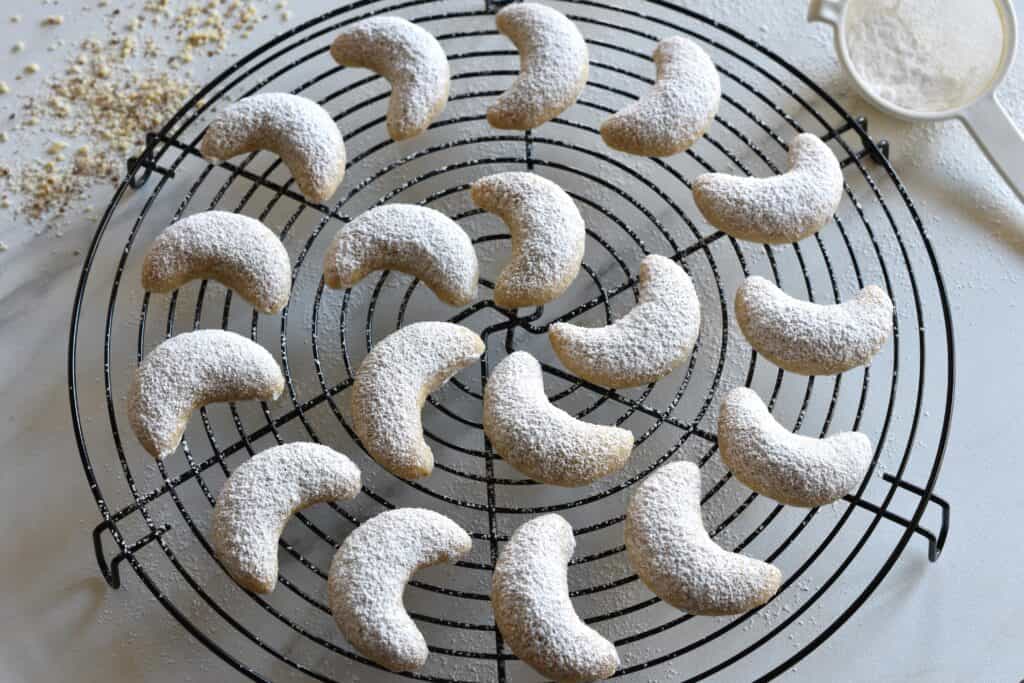
What are Vanillekipferl?
Vanillekipferl are little crescent-shaped, sugarcoated biscuits originating from Vienna in Austria. They’re traditionally made at Christmastime, but they’re enjoyed all year round in Austria, and you can find them in virtually every Viennese Kaffeehaus (coffee shop) and Konditorei (pastry shop).
The Vanillekipferl dates back 400 years when the Austrians celebrated a victory over the Ottoman Turks and created a pastry in the shape of the crescent moon depicted on the Turkish flag.
They are very well known throughout Europe, in particular in Switzerland and Germany, but also in Hungary, Poland, Croatia, Czech Republic, Romania and Slovakia. Here in Switzerland, they’re known as Vanillegipfeli, which means little vanilla croissants or crescents. In Austria and Germany, they’re called Vanillekipferl, which means pretty much the same thing, without the “little”. In English-speaking countries, they are usually known as vanilla crescent biscuits/cookies or vanilla half moons.
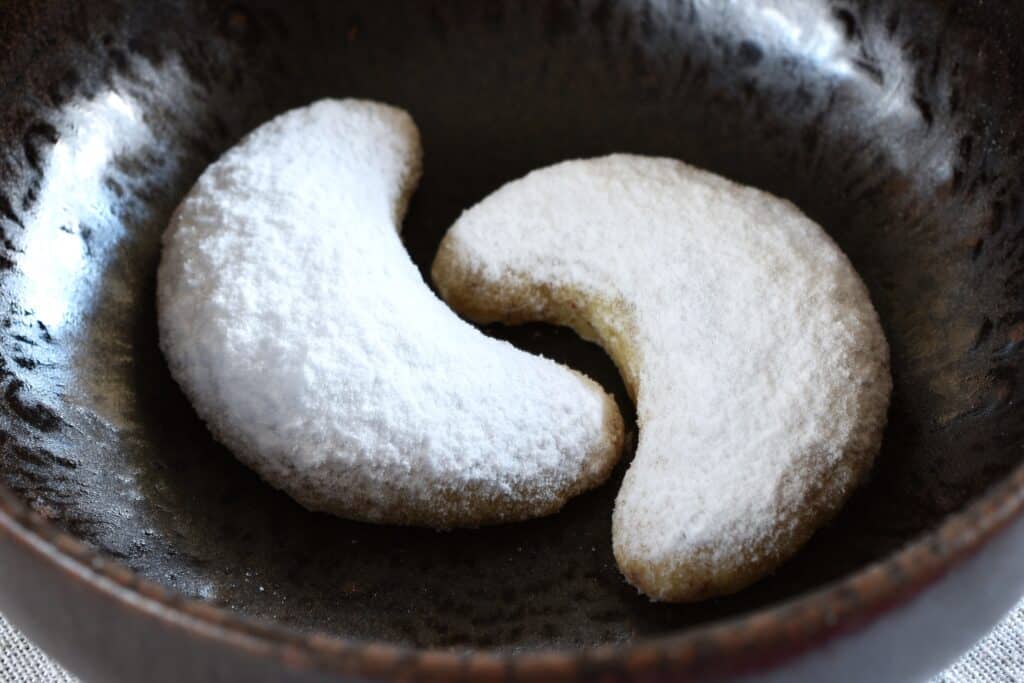
Vanillekipferl and Christmas traditions
Baking Christmas biscuits is a big thing here in Switzerland! We have so many different types – known as guetzli in Swiss German dialect. There are double-layered jam-filled Spitzbuben, cinnamon-flavoured stars called Zimtsterne, plain and simple Mailänderli with a delicate lemony flavour, Vanillegipfeli, and many others! I add other favourites of mine, like chocolate-dipped Scottish shortbread, double chocolate crinkle cookies, and Italian almond cookies.
Christmas baking is an important tradition in all German-speaking countries, and the variety of biscuits is amazing. If you’ve never seen them, it’s difficult to imagine just how many there are. They dedicate entire cookbooks to Christmas biscuits.
The baking usually begins in earnest during the second and third week of December. At our house, it’s traditional to bake biscuits on 8th December, a National holiday for Catholic Cantons like Ticino, where we live. We spend the whole day mixing and rolling out dough, cutting, shaping and baking biscuits.
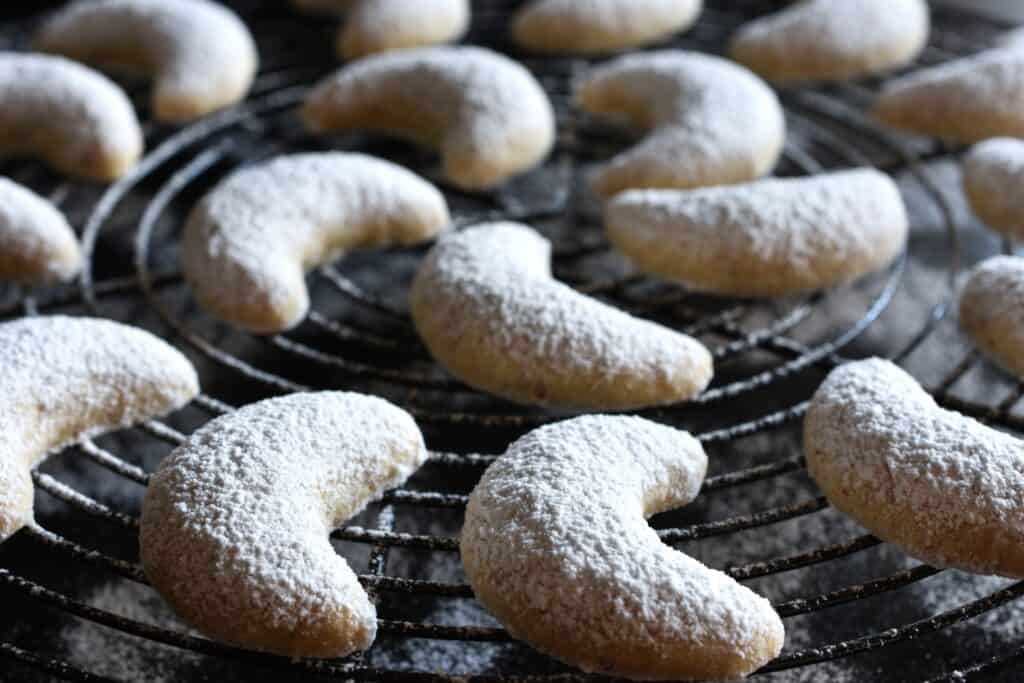
This year, it went on for three consecutive days because I had to test some recipes again before putting them on my blog. Guido loves being a recipe tester – especially if it’s sweet stuff! I had to take photos as well, which always takes me ages. At this time of year, there aren’t many hours of daylight, and sunny days are few and far between, which doesn’t help when you’re trying to take photos in natural light.
Here in Switzerland, Austria and other German-speaking countries, it’s traditional to share packets full of different kinds of Christmas biscuits with friends and family. One type of biscuit that’s never missing is the iconic Vanillegipfeli. They are also my son-in-law’s favourite! He calls them Vanillemondli (little vanilla moons), and of course, he gets a packet full all to himself on Christmas Day.
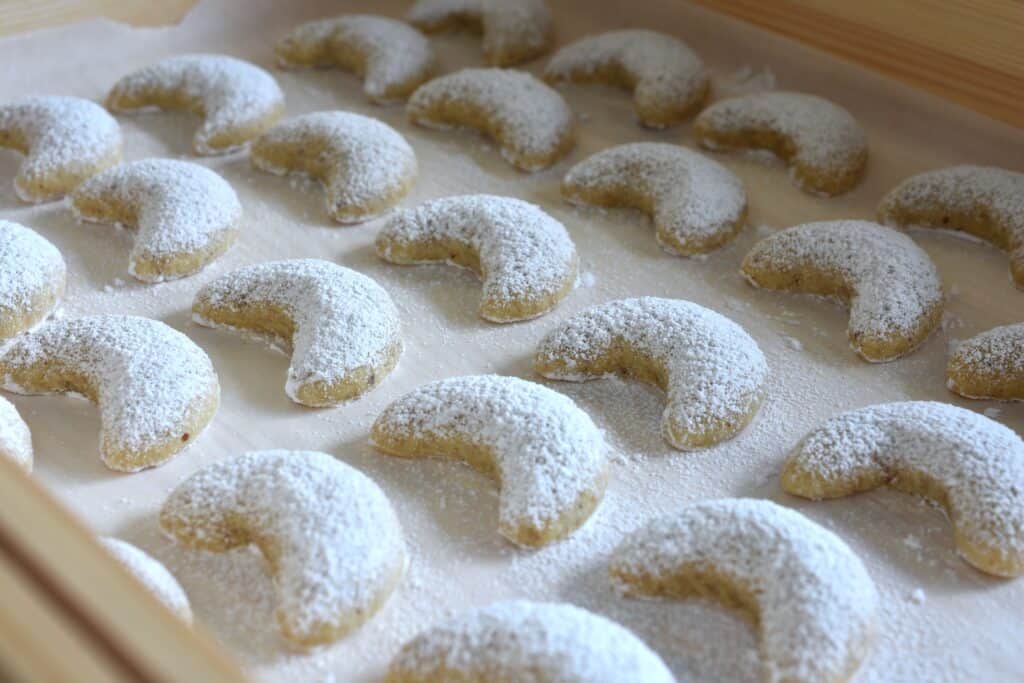
How to make vegan vanillekipferl (vanilla crescent cookies)
Ingredients
You’ll find the exact quantities of each ingredient in the recipe card at the bottom of the page.
Butter
Butter is the only non-vegan ingredient in a traditional Vanillekipferl recipe. You can easily replace the butter with a vegan alternative, like Flora or Vegan Block. I used Vegan Block for this recipe. It’s my favourite. I love the slightly salty flavour – it reminds me of British butter when I lived in England. The ingredients are OK too. This is a very forgiving recipe, so any kind of vegan butter should work.

Sugar
I use brown demerara sugar because most white (and some brown) sugars aren’t vegan. Read about the use of bone char (often referred to as natural carbon) in sugar here. It’s best to use finely ground sugar in this recipe. If you only have coarsely ground sugar, you could grind it to a finer consistency in a blender.
Almonds
You can use either blanched (aka peeled) almonds or whole (unpeeled) brown ones. Blanched almonds have had their skins removed and are therefore white. These will yield light-coloured Vanillekipferl. For a more rustic appearance, with little brown flecks like you can see in the photos, use unpeeled almonds.
I use ground almonds for convenience, as they’re readily available here in Switzerland. If you only have whole almonds, no problem! Just put them in a grinder or blender and grind them to a coarse powder. Be careful not to overgrind them, or you’ll end up with almond butter! And remember to sieve the ground almonds afterwards to filter out any lumps of almonds the blender or grinder missed.
You could substitute the almonds with hazelnuts or another nut of your choice.
Flour
You’ll need plain, all-purpose flour for this recipe. If you prefer, you could use wholemeal.
Vanilla
In this recipe, we’ll be adding vanilla to the biscuit dough rather than using vanilla sugar for the dusting. This is because it’s practically impossible to find vanilla-flavoured icing sugar. Instead, we can add a few drops of vanilla extract, vanilla essence, or granulated vanilla sugar to the dough. These are easy to find in most places. I use vanilla extract.
Icing sugar
For dusting the Vanillekipferl, you’ll need icing sugar – the fine, powdered sugar also known as confectioner’s sugar. Traditionally, Vanillekipferl are dusted with vanilla-flavoured icing sugar, which is hard to find and may or may not be vegan. Unflavoured icing sugar usually isn’t vegan, either. You can easily solve that problem by buying vegan granulated white sugar and grinding it to a fine powder in a blender or grinder. No one will ever notice that the vanilla flavour is in the biscuit itself rather than in the sugar coating!
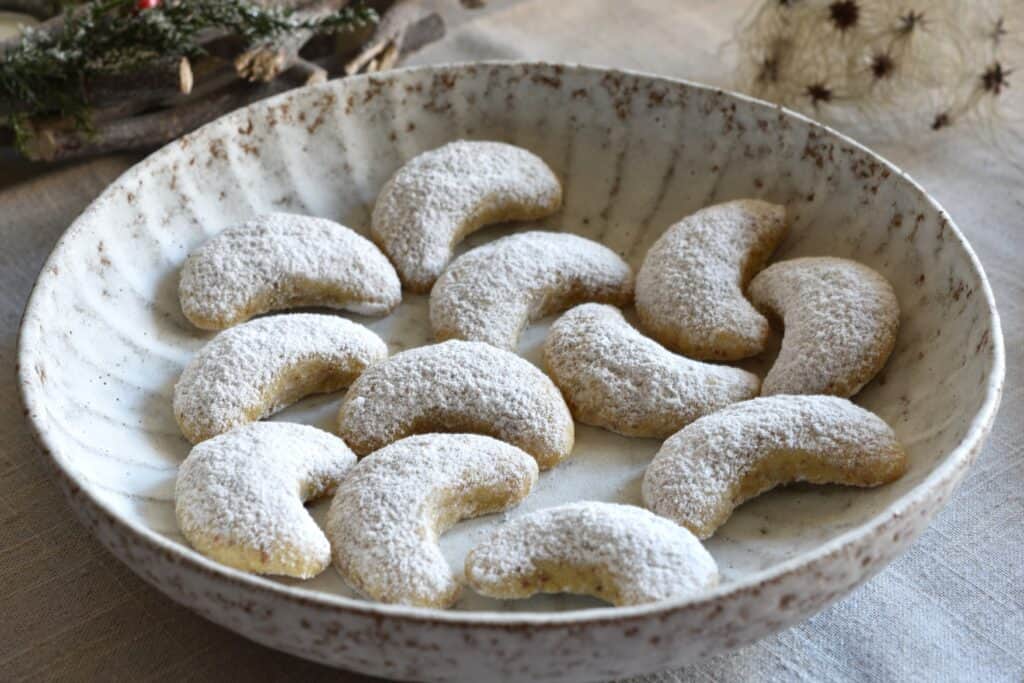
How to make vegan vanillekipferl (vanilla crescent cookies)
Instructions
Following this vegan vanillekipferl recipe couldn’t be easier! Just follow the steps below or jump to the recipe card at the end of this page for step-by-step instructions with photos.
How to make the dough
Simply mix all the ingredients together, first with a spatula and then with your hands. Leave the vegan butter out of the fridge to soften beforehand – that way, mixing the ingredients will be much easier. I don’t recommend using a food processor to mix the ingredients because it activates the gluten in the flour and alters the consistency. You can use the dough immediately or wrap it in cling film and put it in the fridge for later use.
How to shape vanillekiferl
It’s a bit fiddly to create the crescent-shaped Kipferl, but I’ve made it easier for you by creating easy-to-follow, step-by-step instructions with photos. You’ll find them in the recipe card below. The trick is to warm the biscuit paste well in your hands before trying to model it into a crescent shape.
After the resting time, break off pieces weighing approximately 11 g (about the size of a large cherry). Then, roll each piece, first into a ball and then into a rope with pointed ends and a bulging middle. Shape them into crescents and lay them on a cold baking tray lined with a sheet of baking paper.
Important tip
Before baking, put the Vanillekipferl in the fridge (or outside if it’s cold) so that they become firm again – this will stop them from spreading and losing their shape during baking.
How to bake Vegan vanillekipferl
Bake the Vanillegipfeli in the centre of the oven at 180 °C for 10 – 12 minutes. They are done when the tips are just starting to change colour. Resist the temptation to bake the biscuits for longer because they look pale. That’s how they should be. Baking your vanilla crescent cookies for too long will make them hard.
They’ll be very soft when they come out of the oven, so leave them on the baking sheet until they have cooled and hardened.
How to sugarcoat vegan Vanillekipferl
When the Vanillegipfeli have cooled down completely, you can coat them in icing sugar. They are quite fragile and break easily, so take care when handling them, especially when they’re still warm. Don’t try to remove them from the oven tray until they have hardened. It’s a good idea to sprinkle the icing sugar over the biscuits with a fine-meshed sieve rather than tossing them in it. I once tried tossing them in the icing sugar, and I ended up breaking quite a few. Because they should be coated all over, I usually turn them upside down and dust the underside first. Then, I turn them over and dust the top side. That way, you won’t have fingerprints on the top side. A fine-meshed sieve does a great job.

How long do vegan Vanillekipferl keep?
They’ll keep for several weeks if you put them in a biscuit tin and store them in a cool place. If you can hold back from eating them all, that is!
Can you freeze vanilla crescent cookies?
Yes, you can, but it’s best to freeze them without the icing sugar. Once the Vanillekipferl have cooled down completely, put them in an airtight container (freezer-safe glass is best) with a lid. A ziplock freezer bag would also work, but the biscuits will be more prone to breakage (if you rummage around in the freezer like I do).
How to defrost them
Allow the Vanillekipferl to defrost at room temperature on a rack. Once they are completely thawed out and dry, you can sprinkle the icing sugar on them, as explained above.
I’m sure you’ll love this recipe for homemade vegan vanilla crescent cookies! If you try it and like it, I’d love to hear about it! Let me know in the comments below, or take a quick pic and share it on social media. Don’t forget to tag me on Instagram or Facebook vegan_hot_stuff. I love seeing your re-creations!
I hope you enjoy this recipe for vegan vanillekipferl! If you do, it would be great if you could give it a star rating and leave a comment below! It helps other readers find my content and posts and ultimately makes my blog more successful! Thanks so much for your support! Deborah xx
Before you go, maybe you’d like to take a look at some other great vegan Christmas cookie recipes…

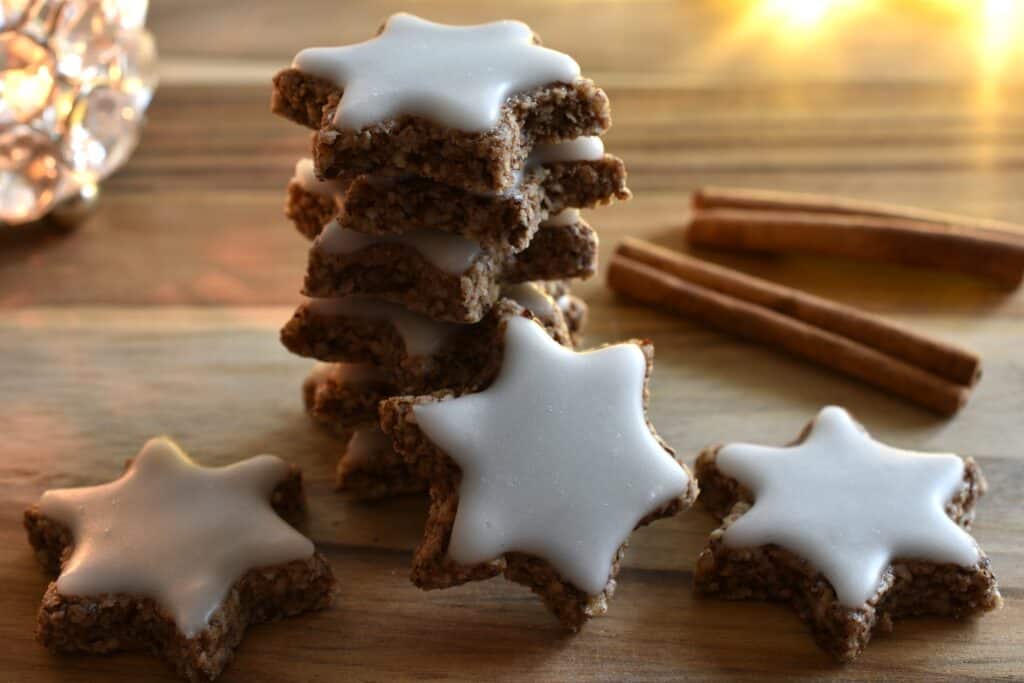
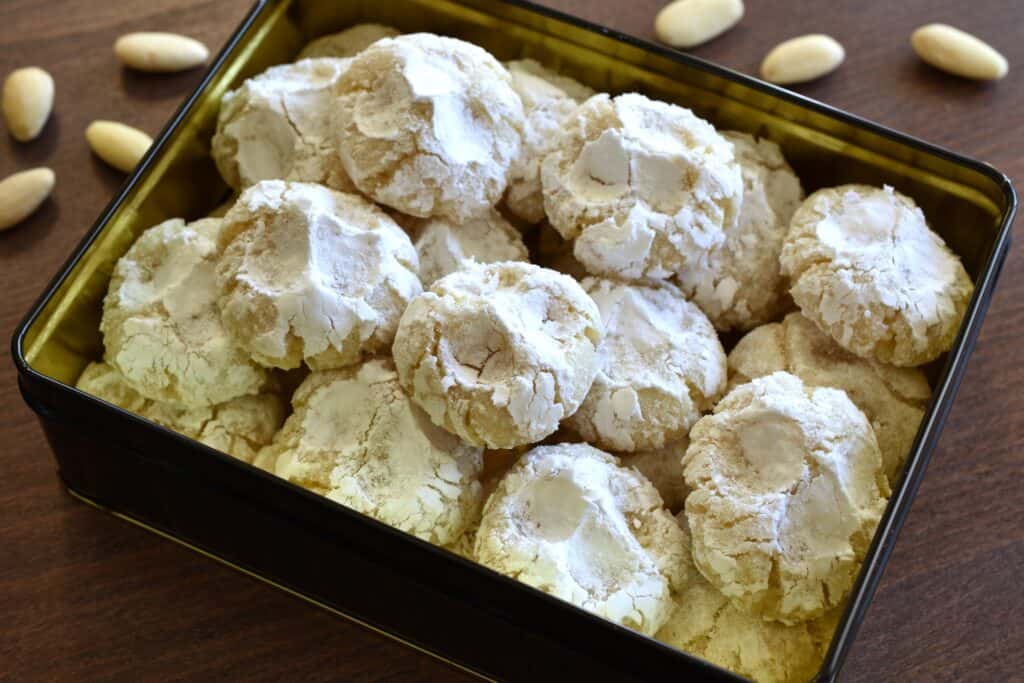
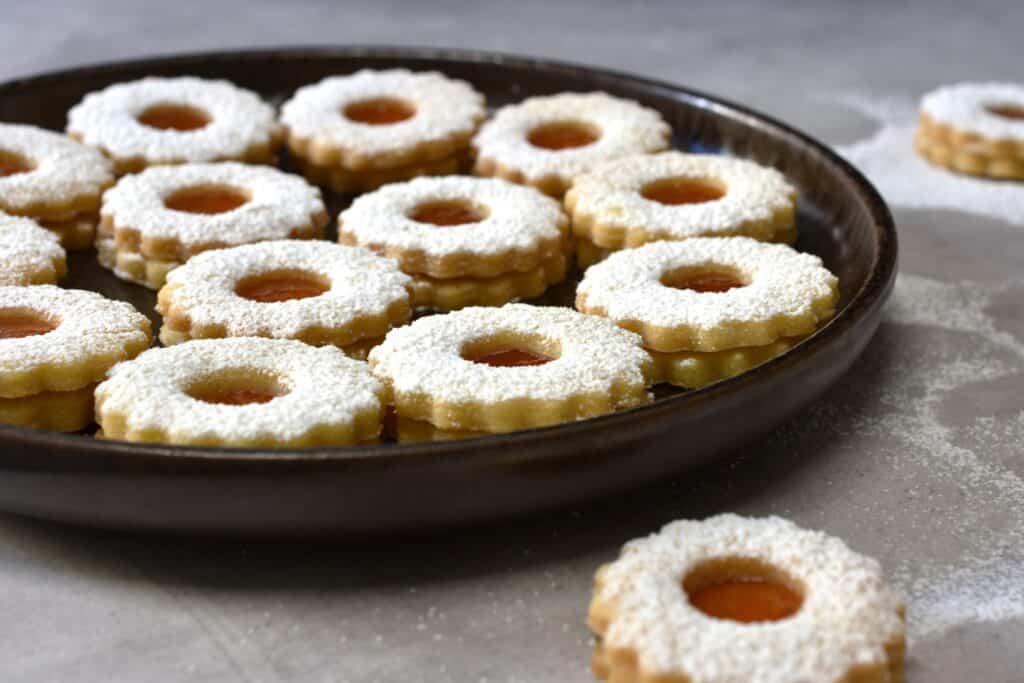
Would you like to receive my recipes as soon as I publish them? Subscribe below!


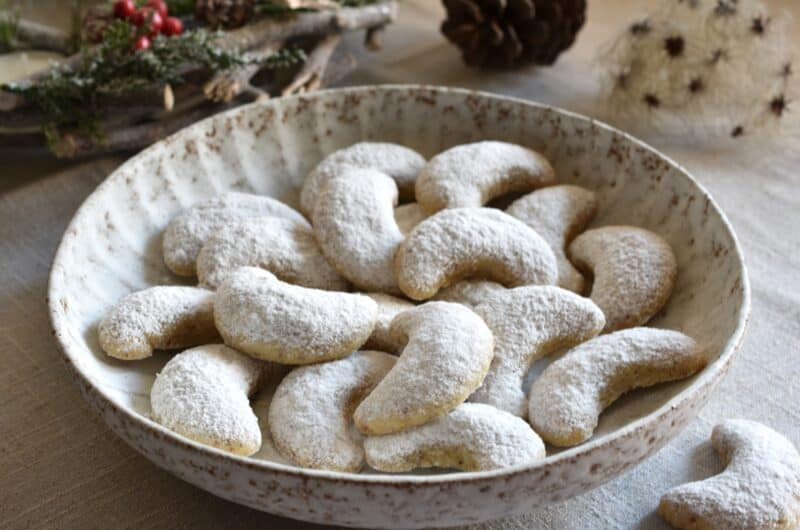
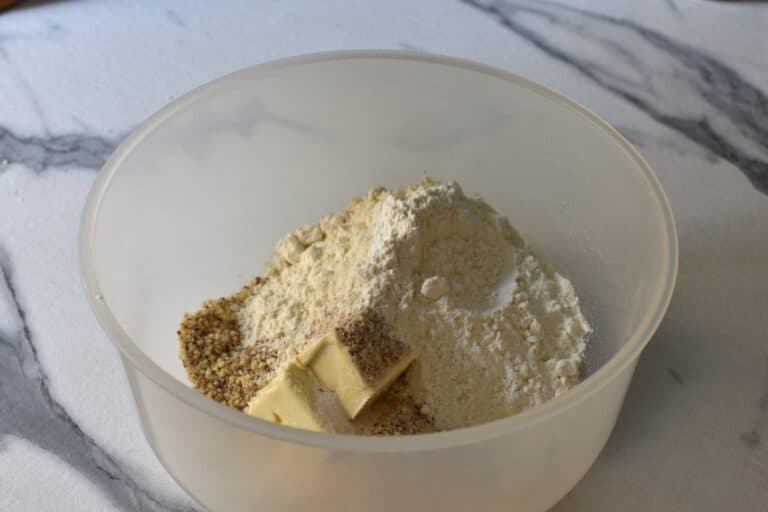
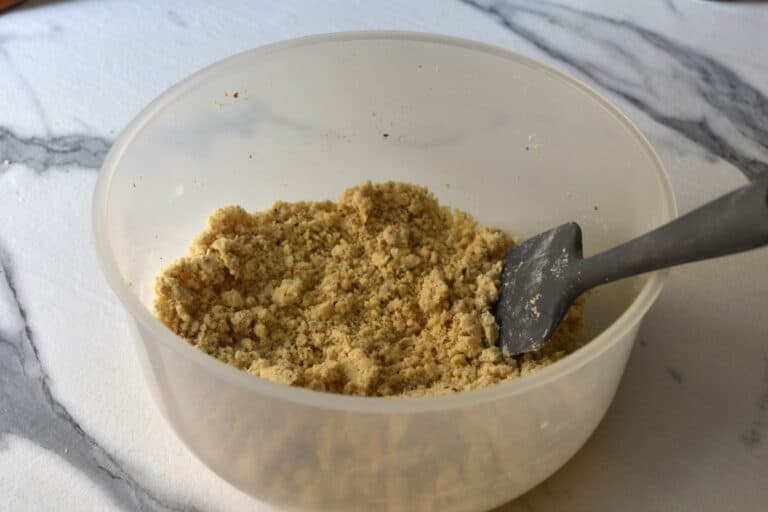
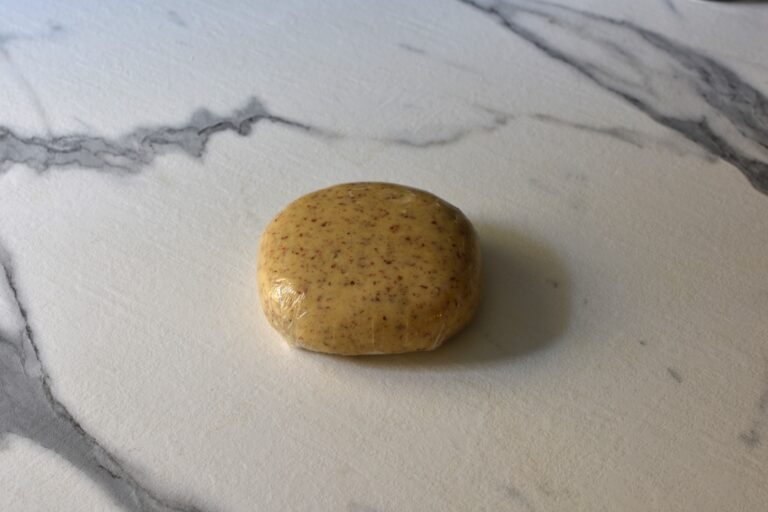
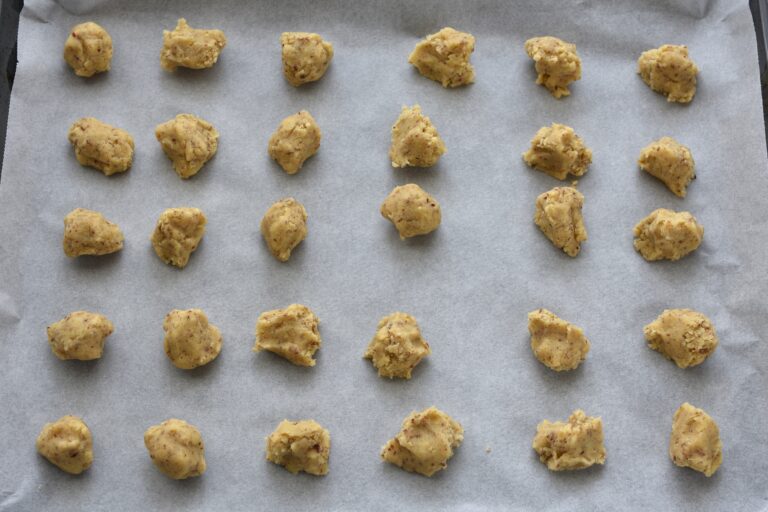
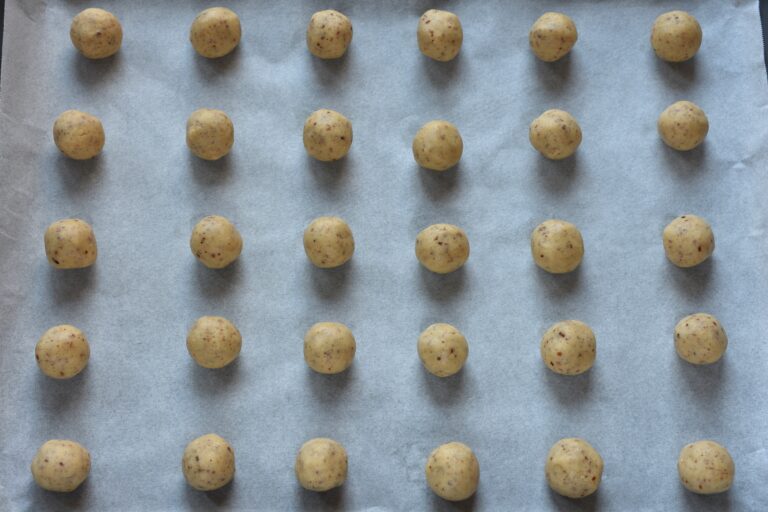
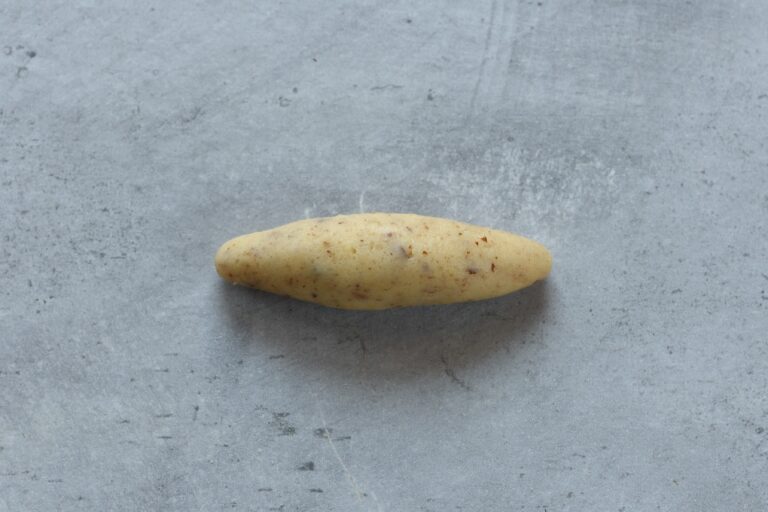
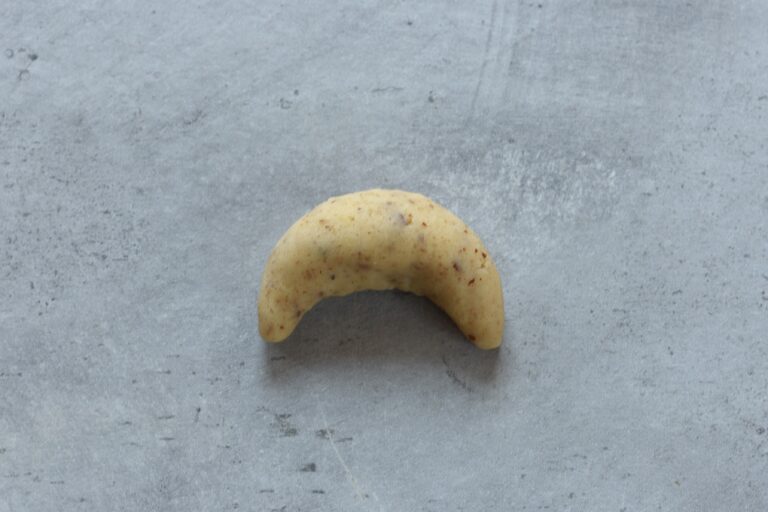
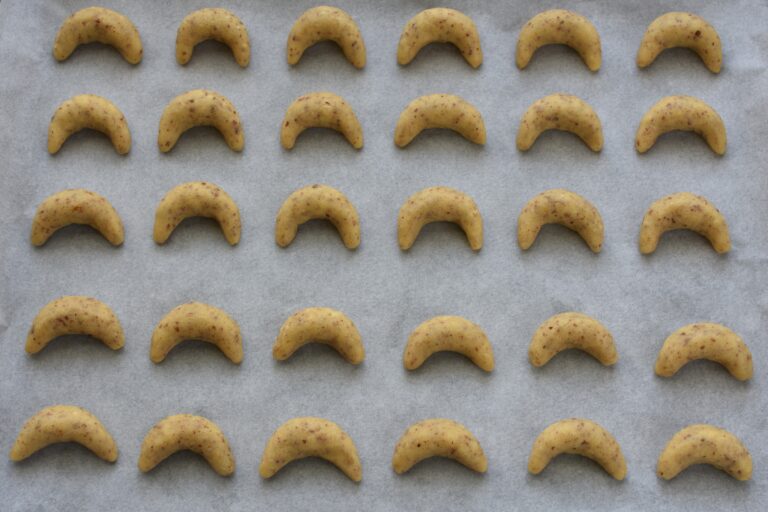

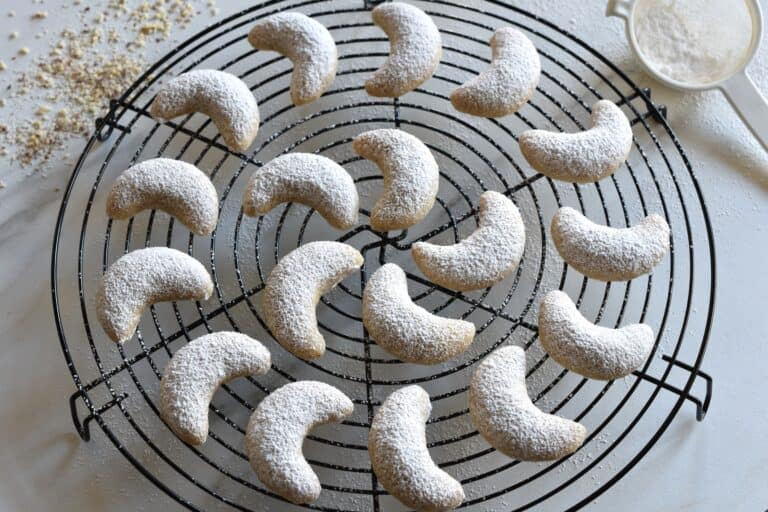
My favorite cookies to make, simple and delicious.
For Christmas they weren’t enough, everyone ate them fresh out of the oven.
Went down a storm!!!
Wow! That’s good to hear – I’m really glad everyone liked them.